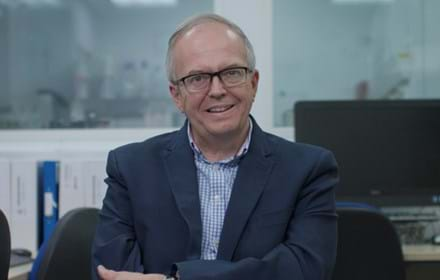
Report - Online personalised care and latest technology options explored at international diabetes conference
DRWF Research Manager Dr Eleanor Kennedy’s blog reports from Day Two of the 14th International Conference on Diabetes Technologies & Treatments (ATTD 2021) held this year as a fully virtual meeting.
Day Two of the 14th International Conference on Advanced Technologies & Treatments for Diabetes (ATTD 2021) dawns, not in Paris as was planned in an ideal, non-Covid-19 world, but, as with all of my conference blogs recently, from my kitchen table!
A vision of care for children with diabetes
Professor Thomas Danne from the Children’s Hospital Auf der Bult Hannover introduced the ‘Thriving for Clinical Excellence’ session, bringing together four experts who have put clinical excellence based on real data on the diabetes agenda.
Professor Danne himself reviewed the last 10 years of the SWEET project, of which he is Chairman. SWEET, with formal ties to ISPAD - the International Society for Pediatric and Adolescent Diabetes, is a network of paediatric diabetes centres which collects data, agrees standards of care, and carries out peer review and benchmarking.
Professor Danne said: “Our vision is equal high-quality care for children with diabetes.”
On glycaemic control, SWEET showed an improvement in HbA1c, to a median of 7.7%, in all age groups from 2016 to 2019 compared to 2008 to 2010 in most centres. Analysis showed that this improvement can be attributed to the higher take up of insulin pumps and continuous glucose monitoring (CGM) over the years. And when it came to glycaemic (blood sugar) targets, nearly half the centres used the ISPAD goal of 7% but some have higher, and some have lower targets.
Professor Danne added: “Interestingly, setting targets does play a role in achieving metabolic controls. Those centres with lower targets had better metabolic control.”
SWEET has also looked at how paediatric diabetes care has fared during the omnipresent pandemic by analysing data according to Covid-19 mortality in the background population. The good news is that glycaemic control was generally maintained during the first wave.

How about technology?
There was not much change in pump use, but CGM use increased significantly in all groups of Covid-19 mortality.
Professor Danne said: “I think what it tells us is how important technology is in diabetes.”
The next step is to make more direct contact with patients and their families, in order to explore parental distress and its relationship to clinical outcomes and use of technologies.
Professor Danne concluded: “SWEET has really grown and we are still growing. If you are interested, please join us.”
Pros and cons of the use of diabetes technology in children and adolescents
Andrea Scaramuzza from Cremona in Italy reviewed the pros and cons of the use of diabetes technology in children and adolescents, noting that few still achieve the recommended glucose targets. Dedicated to helping people get more out of diabetes technology, his team has done a study that shows that after just one week from upgrading to Control-IQ, an advanced hybrid closed-loop technology with a group of 15-year-olds, Time in Range went up to a sustained 75% from 67%. They also evaluated the impact of a virtual educational camp with 43 children using a closed-loop control system, also with Control-IQ, with similar improvements.

Online management of diabetes with apps and data sharing for personalised care
Satish Garg, a professor in paediatrics at the University of Colorado in Denver, US then introduced a session on digital/virtual diabetes clinics – a highlight of ATTD21 given how telemedicine and diabetes technology have come to the fore during the pandemic.
Drawing on his own research at the Barbara Davis Diabetes Centre, where CGM use is above the national average at 80%, he noted that Time in Range has actually improved with virtual clinics. Looking to the future of technology, he believes that solutions like smart insulin pens, used with multiple daily injections and CGM, could be the best way to manage diabetes globally, with data being shared remotely through online apps and digital cloud storage.
Professor Garg said: “We don’t know what the future is for telemedicine, but I hope it is here to stay as it will remove many barriers and patients can receive more equal care.”
Lori Laffel from the world-famous Joslin Diabetes Centre, based in Boston, US, spoke about telemedicine for routine follow-up in paediatric type 1 diabetes care. She highlighted the importance of frequent visits and the presence of family in achieving good glucose control.
Professor Laffel said: “Virtual care may encourage more contact and presence of one or more parents. Telehealth is therefore a potential way to improve care and outcomes.”
She noted that remote care is nothing new, as telephone calls played an important role in the DCCT study.
Going forward, a hybrid approach with remote, maybe monthly, and less frequent face-to-face care may help improve outcomes in the paediatric/adolescent group, she concluded.
Democratising best practice diabetes care options
Finally, Michael Haller from the University of Florida spoke about the ECHO (Extension for Community Outcomes) project – a big team effort with Stanford University in California, US.
Dr Haller said: “ECHO is designed to democratise care and get to best practice care to underserved communities,” he explained. Put simply, ECHO is a hub-and-spoke knowledge sharing network, with the hubs using videoconferencing with diabetes specialists to conduct virtual clinics with community healthcare providers. It differs from traditional telemedicine in having a potentially huge patient reach.
“If the community provider has a problem, they can reach us in real time for a consult. We also use community peer coaches with lived experience of diabetes. We hope this will have a trickle-down effect to help people with diabetes who don’t usually see a specialist.”
Data from the ECHO pilot programme show many benefits including a 1.21% fall in HbA1c over six months, which very few other things in diabetes care can provide,
Dr Haller concluded: “Our hope at the end of this trial is to be able to prove to payers and ourselves that ECHO can really improve outcomes for people with diabetes and the community.”
Support DRWF by making a donation here
Find out more about DRWF-funded research here
Find out more about DRWF fundraising here
For latest update follow DRWF on Facebook, Instagram and Twitter
To receive the charity’s latest bulletins as they become available, please sign up here
Read DRWF diabetes information leaflets here
Join the Diabetes Wellness Network here
Recent News


